| کد مقاله | کد نشریه | سال انتشار | مقاله انگلیسی | نسخه تمام متن |
|---|---|---|---|---|
| 1766988 | 1020172 | 2011 | 12 صفحه PDF | دانلود رایگان |
عنوان انگلیسی مقاله ISI
GNSS geodetic techniques for time and frequency transfer applications
دانلود مقاله + سفارش ترجمه
دانلود مقاله ISI انگلیسی
رایگان برای ایرانیان
کلمات کلیدی
موضوعات مرتبط
مهندسی و علوم پایه
علوم زمین و سیارات
علوم فضا و نجوم
پیش نمایش صفحه اول مقاله

چکیده انگلیسی
We performed an initial analysis of the pseudorange data of the GIOVE-B satellite, one of the two experimental Galileo satellites currently in operation, for time transfer.1 For this specific aim, software was developed to process the GIOVE-B raw pseudoranges and broadcast navigation messages collected by the Galileo Experimental Sensor Stations (GESS) tracking network, yielding station clock phase errors with respect to the Experimental Galileo System Time (EGST). The software also allows processing the Global Positioning System (GPS) P1 and P2 pseudorange data with broadcast navigation message collected at the same stations to obtain the station clock phase errors with respect to the GPS system time (GPST). Differencing these solutions between stations provides two independent means of GNSS time transfer. We compared these time transfer results with Precise Point Positioning (PPP) method applied to GPS data in combined carrier-phase and pseudorange mode as well as in pseudorange-only mode to show their relative merits. The PPP solutions in combined carrier-phase and pseudorange mode showed the least instability of the methods tested herein at all scales, at few parts in 1015 at 1 day for the stations processed, following a tauâ½ interval dependency. Conversely, the PPP solutions in pseudorange-only mode are an order of magnitude worst (few parts in 1014 at 1 day for the stations processed) following a tauâ1 power-law, but slightly better than the single-satellite raw GPS time transfer solutions obtained using the developed software, since the PPP least-squares solution effectively averages the pseudorange noise. The pseudorange noise levels estimated from PPP pseudorange residuals and from clock solution comparisons are largely consistent, providing a validation of our software operation. The raw GIOVE-B time transfer, as implemented in this work, proves to be slightly better than single-satellite raw GPS satellite time transfer, at least in the medium term. However, one of the processed stations shows a combined GPS P1 and P2 pseudorange noise level at 2 m, a factor 2 worst than usually seen for geodetic receivers, so the GPS time transfer results may not be at their best for the cases processed. Over the short term, the GPS single-satellite time transfer instability outperforms the GIOVE-B by an order of magnitude at 1 s interval, which would be due to the different characteristics of the tracking loop filters for GPS P1 and P2 on one hand and the GIOVE-B signals on the other. Even at this preliminary stage and using an experimental satellite system, results show that the GIOVE-B (and hence Galileo) signals offer interesting perspectives for high precision time transfer between metrological laboratories.
ناشر
Database: Elsevier - ScienceDirect (ساینس دایرکت)
Journal: Advances in Space Research - Volume 47, Issue 2, 15 January 2011, Pages 253-264
Journal: Advances in Space Research - Volume 47, Issue 2, 15 January 2011, Pages 253-264
نویسندگان
François Lahaye, Giancarlo Cerretto, Patrizia Tavella,